The new battleground
Acceleration of the digital era has led to seismic shifts in consumer behavior and the fiercest competition in history—and the playing field for winning customers’ hearts, minds and wallets has dramatically changed. Product attributes have taken a back seat to customer experience (CX), making it the new arena where today’s brands compete. Brands that are investing in technologies and strategies that enable them to make their customers’ experiences easier, more convenient and personalized will have a competitive edge.
Achieving sustainable, profitable growth is challenging—even under the best economic conditions—and most enterprises spend the bulk of their energy and resources on new customer acquisition, only to have those customers churn early on. According to McKinsey & Company, there’s a strong correlation between companies’ CX ratings and their revenue growth. In fact, they report that a strategy focused on improving the experience of existing customers, known as experience-led growth, can deliver breakthrough growth for companies—often more than double that of their industry peers. Specifically, this approach can increase cross-sell rates by up to 25%, boost share-of-wallet by up to 10% and improve customer satisfaction and engagement by up to 30%.


But delivering a great customer experience can be complicated—especially when customer expectations are a moving target. Consumers have more and more choices, so now’s the time to ramp up your brand’s ability to rapidly adapt to evolving needs and opportunities. This guide is designed to help enterprises better understand:
-
Why improving your customers’ experiences is so challenging
-
The risks of ignoring it or falling behind
-
The benefits of doing it well
-
How personalization and loyalty play key roles in closing your customer experience gap
-
How loyalty helps you achieve your top CX goals
-
The importance of having the right technology
-
Next steps to get started
The customer experience gap is wider than ever
Unless you’ve been binge-watching Yellowstone or The Bear, it’s no secret that today’s consumers expect personalized experiences. And, in reality, this has always been true, it’s just more challenging for brands to deliver since consumers now shop in so many places.
McKinsey & Company reports that 71% of consumers expect companies to personalize interactions, and 76% get frustrated when this doesn’t happen. While this isn’t a startling revelation for most brands, knowing it and delivering it are two different things.
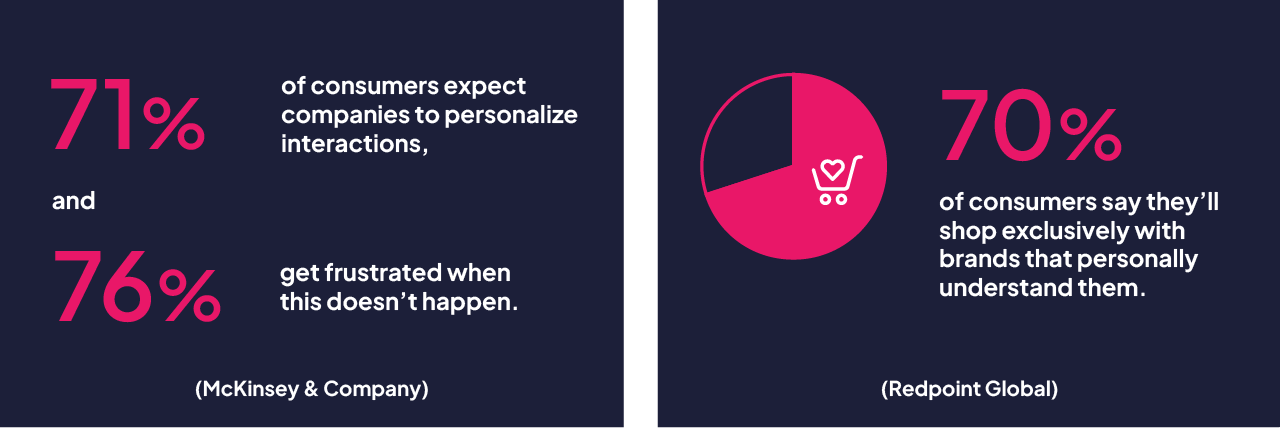
Modern consumers are more diverse—with more complex needs and preferences. But many industries are built for mass production, distribution and marketing. And legacy systems and strategies simply don’t support today’s shoppers’ expectations for personalized experiences. The good news is there’s a huge opportunity for brands that get personalization right. And loyalty can be key in bridging that gap by helping brands lean into a more personalized approach.
“Customer expectations are growing; customers are craving more personalization from brands and more authentic and meaningful relationships. At the same time, the evolution of technology, accessibility and the volume of information available have transformed and will continue to transform the way consumers interact with brands. Added to this is the pandemic that forced many customers to go online for the first time or reinforced the digital behaviors of those who had already embraced ecommerce. More customers expect to be recognized across all their interactions with a brand, and to have a seamless experience between online and offline, regardless of the channel they interact with. It’s crucial for brands to stay tuned and adapt their strategy to changing customer expectations.”
– Andréanne Rondeau, Loyalty Expert, stratLX
What is personalization?
Personalization is nothing new. Amazon began its’ quest to be the most customer-centric company on earth more than 20 years ago. But there’s no universal definition—and it can differ between brands and consumers.
“Personalization is far more than just offering discounts on purchases, it’s about the whole experience starting from the moment they sign up. In today’s data-driven world, you should use what information you have to the best of your ability to create a truly engaging and rewarding experience. Some of the most successful loyalty programs around are the ones that gain the attention of a customer from the very start by presenting them with a stylish, memorable welcome pack that incorporates a physical loyalty card personalized with their name. This makes the customer feel more important and valuable than if they were simply given a generic card. It also makes them more likely to add the card to their wallet or purse where it’ll be a constant reminder of your brand.”
– Adam Unsworth, Managing Director at Precision Card Services
In its simplest form, a personalized experience is any interaction that’s tailored to an individual’s specific needs and preferences. From product recommendations to marketing emails and loyalty rewards, there are countless opportunities to engage shoppers and personalize their experiences on an individual basis.
Consumers define personalization as a seamless, consistent, relevant experience no matter where they engage or shop. Simon Chapman, Director of SA and Enablement at Optimizely offers this view of personalization from a consumer’s perspective:


“The digital experience you design needs to reflect the understanding that customers don’t think in terms of separate channels or stages like mobile versus in store. Everything is interconnected and personalizing the customer journey has never been more important. You need to consider the customer holistically and adapt your processes to fit their individual needs instead of trying to mold their needs to fit your processes.”
– Adobe
Adobe defines personalization as a process that addresses every touchpoint of a customer’s shopping journey and provides each consumer with a unique experience based on real-time intent, historical browsing and purchasing data, and insights derived from analytics. The robust zero- and first-party data that loyalty provides, through functionality like progressive profiling, is essential to delivering true personalization. Forbes describes loyalty and personalization as two sides of the same coin.
“Personalization is the art of transforming a one-size-fits-all experience into a tailored journey that delights and engages each individual user. It’s not just about showing the right content to the right person, it’s about creating a tailored experience that connects with the individual on a deeper level.”
– Simon Chapman, Director of SA and Enablement, Optimizely
Perhaps personalization is better defined in terms of feelings and outcomes. When done right, personalization makes shoppers feel special because the brand knows them well enough to send them only the most relevant products and offers. The consumer-brand relationship transforms into more of a conversation between friends. For brands, personalization enables positive business outcomes that include differentiation, increased engagement, long-term loyalty and growth.
“Personalization is what makes the customer feel special. Because when it’s well done, they may not even realize it was personalized but they’ll feel recognized and that’s the magic that happens.”
– Andréanne Rondeau, Founder, stratLX
According to Andréanne, everything comes down to tailoring the product, service and experience to the individual. Hear more of what Andréanne has to say about personalization in this episode of our Get Personal with Loyalty podcast.
“B2B buyers now expect the same level of personalization they experience in their B2C interactions. The B2B buying process is often complex and involves multiple stakeholders. Personalization simplifies this process by providing customized catalogs, tailored pricing agreements and intuitive user interfaces. By reducing friction and making the buying journey more efficient, companies can further enhance customer satisfaction. In B2B ecommerce, personalization fosters stronger relationships, enhances customer engagement and retention, and ultimately contributes to business growth and profitability.”
– Polyna Berlin, Senior Partner Marketing Manager, Spryker
Annex Cloud looks at personalization from two perspectives that support each other but are different:
-
Programmatic—What are you trying to achieve? For example, your customers are vegan, so they don’t want to see promos on brats.
-
Configuration—How do you make that happen? This includes storing data, creating segments and backend mechanics.
Regardless of how you define it, the unfortunate reality is many brands aren’t even doing the basics of what’s expected. And that can make a brand extremely vulnerable.
Why personalization is critical for improving CX and growth
Today’s consumers have more choices than ever, and they expect personalization. Brands can’t afford not to personalize their customers’ experiences. There’s too much at stake. Let’s take a closer look at both the risks and benefits of personalization.
“The financial rewards for brands that meet or exceed customer expectations for an omnichannel, personalized CX are undisputable. Cost avoidance and revenue growth are both achievable for organizations that have the right foundational capabilities to deliver the type of personalization consumers’ demand. Enterprise alignment between their customer-centric strategies and their underlying technology capabilities is key to delivering long-term loyalty and customer value.”
– John Nash, Chief Marketing and Strategy Officer, Redpoint Global
Risks of not personalizing customer experiences (or getting it wrong)
McKinsey & Company refers to personalization as the ‘hygiene factor’, meaning customers take it for granted—but if a retailer gets it wrong, they’ll take their business elsewhere. And it’s often their best customers walking out the door. Brands that don’t make a consistent, data-led effort risk losing revenue, customers and potentially their business.
Every brand needs to personalize in today’s competitive marketplace. And by personalize I don’t mean adding the customer’s name to the email, it’s got to go much deeper than this. We’re all very used to targeted product offers, based on our purchase behavior, from our retail partners and relevant entertainment scheduling from Netflix and Spotify. This level of personalization is now table stakes. It’s getting more and more challenging for brands compete in this space as third-party data collection disappears. Customers are more likely to share data with brands they like and value, but much less likely if the brand uses the data badly or is irrelevant.
– Tom Peace, Managing Director, The Loyalty People
According to a Redpoint Global Survey, 63% of consumers say personalization is the standard of service today. If you don’t offer a personalized experience, customers will shift their loyalty to a competitor that does.

“Companies may balk at the price tag associated with digital transformation, but the cost of staying where you’re at is often significantly steeper. Brands that don’t prioritize investments in strong loyalty and personalization strategies, and the technologies that power them, will be left behind. It’s simply too easy for today’s consumers to switch to a brand that has made those investments.”
– Erin Raese, SVP of Growth & Revenue, Annex Cloud
Asking your customers questions but getting personalization wrong can be more damaging than not doing it at all. This can lead to customer frustration, bad word-of-mouth, even lost customers. The Loyalty People’s Managing Director Tom Peace advises brands to use customer data well. Once you know something about them don’t ignore it, especially if they’ve told you something about themselves. He cautions, however, to be careful with purchase data. One purchase of nappies doesn’t make the customer a parent. Look for trends over short periods rather than spikes in behavior if you can. Tom also suggests that brands be aware customers can be in multiple behavioral segments and want different experiences from the same brand. He says dynamic segments can help brands manage this.
Let’s look at three examples of personalization gone wrong:

“It’s the most important, most misunderstood and abused element of marketing. Too much of today’s marketing personalization is nothing more than stalking. The primary premise of true personalization is to place the consumers’ unmet needs at the center. All too often, marketers think of consumers as a target rather than a person. True personalization treats a consumer as a guest in the same manner as you’d wish to be treated.”
– Ian Beavis, Chief Strategy Officer, AMCI

Benefits of personalization
The opportunities for brands that get personalization right are huge. Here are four benefits for organizations that show their customers they care, are paying attention and are using their data to tailor their experiences.
1. Improved revenue growth & ROI
Customers are happy to reward brands that personalize their experiences by spending more money with them. Personalization also drives higher conversion rates, improving ROI.

2. Increased repeat purchases & engagement
Using customer data to serve up more relevant and meaningful experiences gives them more reasons to keep coming back and engage with a brand. Insider Intelligence reports that 54% of marketers worldwide saw better brand engagement when using personalization. This led to higher conversion rates.

“People can buy almost any product from tens if not hundreds of brands. Unless you want to solely compete on price, then experience and personalization is a differentiator. Personalization is expected and businesses that don’t do it well will suffer. You don’t get better performance without doing more. Personalization is a way to show more content and better products which can generate increased conversion.”
– Jake Pasini, VP of Strategy and Analytics, Listrak
3. Increased loyalty
Receiving personalized communications and offers makes customers feel special and they’ll show their appreciation by being more loyal to a brand.

“Personalization is especially effective at driving repeat engagement and loyalty over time. Recurring interactions create more data from which brands can design ever-more relevant experiences—creating a flywheel effect that generates strong, long-term customer lifetime value and loyalty.”
– McKinsey & Company
4. Increased competitive advantage
Delivering highly personalized customer experiences that leverage customer data to deliver unique value is tough for competitors to imitate and helps differentiate a brand.
“The only way that we’re going to keep people coming back is if we deliver customer experiences that delight the customer and that are differentiated from the experiences they can get elsewhere. If you’re trying to win on price alone, you’re going to lose—there’s only one Amazon that’s going to deliver the lowest priced goods.”
– Avery Worthing-Jones, Senior Vice President of Product Management, Gap Inc.
7 reasons why brands aren’t meeting consumers’ CX expectations
Nearly every brand has personalization and improving customer experience at the top of its priority list, yet most are struggling to make it happen. Why? It requires a tremendous amount of data and modern technology to be able to collect, share, segment and gain insights from your customers’ data—and effectively use it to serve up unique, relevant experiences.
Here are some of the common culprits for being unable to deliver consistent, personalized experiences across every touchpoint.
1. Collecting zero- and first-party data with consent at scale
The phasing out of third-party cookies has turned up the pressure on brands to find a reliable, privacy-friendly way to collect data directly from their customers. Balancing the collection of meaningful data with customer privacy concerns can be tricky.

“With greater omnichannel content integration along with a secular shift to B2B digital commerce, there will be a much greater prominence of earned first-party data with its clear and fair value exchange. This will not only jolt the current dynamics but also turbocharge personalization based on user behavior with a more cost-effective, always-on growth strategy that provides end-to-end customer solutions.”
– Bob Mitchell, Principal/Founder, Mitchell Partnership Alliances, Verizon
2. Siloed data & processes
Forbes reports that many companies have fragmented systems, data and processes that, by design, result in outdated, disjointed customer experiences. This makes it impossible to consistently recognize customers no matter where they engage and shop.
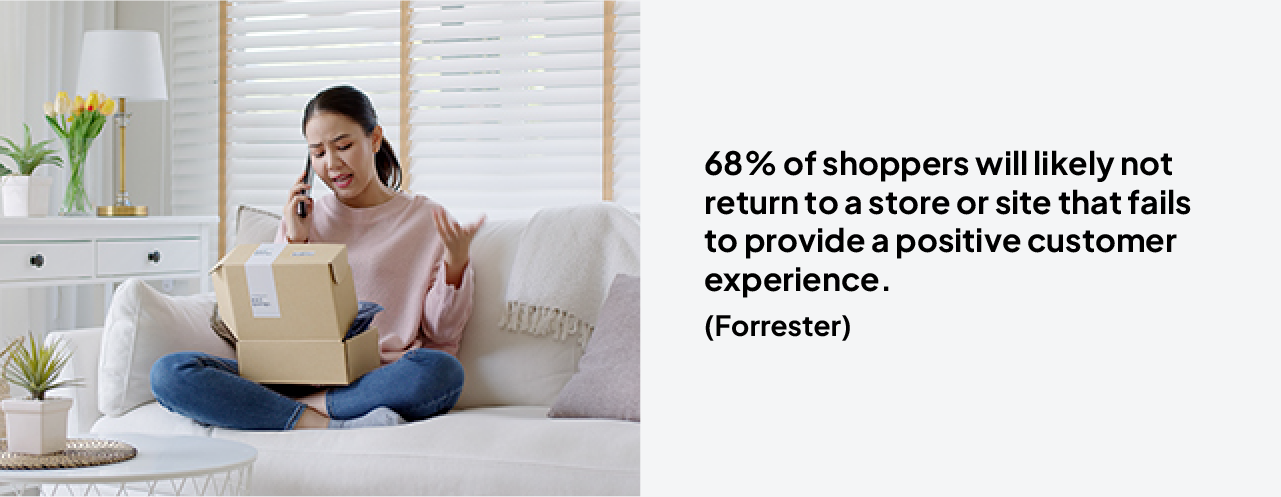
“To drive revenue opportunities with personalized and frictionless experiences, organizations need a deep understanding of each customer they’re engaging with. For example, a seamless buy online, pickup in store (BOPIS) experience provides opportunities for meaningful, omnichannel interactions if personalized effectively. Value is created by serving customers relevant content in real time in the cadence of the journey and their overall needs, intents and preferences. In a BOPIS experience, real-time relevance might manifest itself with a personalized recommendation in the context of the journey, such as an SMS when the customer checks in with an offer on a product complementary to their recent purchase.”
– John Nash, Chief Marketing and Strategy Officer, Redpoint Global
3. Limited legacy systems
Legacy systems aren’t typically integrated with a brand’s entire tech stack to facilitate sharing the same customer intelligence across the enterprise. And, in most cases, time-consuming and costly development is required to make them flexible and scalable—both of which are necessary to keep up with fast-changing customer preferences.
4. Not using customer data to create value or lack of expertise and resources to leverage the data
Customers expect personalized, relevant communications and offers. But according to Forrester, 85% of retailers lack the right capabilities, human resources, technology and processes to improve the customer experience and monetize their data. And Adobe reports many businesses either don’t have a unified customer profile or are unable to turn data into insights in real time. They advise retailers not to confuse segmentation with personalization—that’s only the beginning of the process.

5. Trying to boil the ocean
Many brands try to bite off too much and do it all at once. Too often, they’re so overwhelmed they end up doing nothing, which puts them further and further behind their competitors.
“Collecting data and offering points are table stakes today. And with modern technology, there are now so many ways you can personalize and deliver unique value to your customers. But you don’t have to do it all at once. The right partners can help you identify your most critical moments along your customer experience journey, outline a phased approach that fits your resources and goals, and provide the technology to test along the way.”
– Erin Raese, SVP of Growth & Revenue, Annex Cloud
6. Keeping CX siloed
Brands often assign customer experience to an individual or team, but this is limited thinking. Customer experience needs to be an enterprise-wide commitment and focus. It also requires an overarching plan and strategy, to avoid situations such as individual teams collecting customer data that isn’t merged or acted on consistently.
7. Approaching CX as one-and-done
Customer experience isn’t a task to check off your to-do list. It’s an always-evolving commitment. GK5A Principal and Chief Strategist Greg Kihlstrom advises organizations to implement a customer journey operations team that focuses on the overall customer experience—including managing the customer journey from awareness to post-purchase—and ensuring it’s consistent and positive across every touchpoint.
While not a new concept, it’s time for brands to close the personalization gap between their customers’ expectations and their ability to deliver. And loyalty can help brands get there.
How loyalty can lead the way to a better CX
According to McKinsey & Company, most brands react to fierce competition by becoming more aggressive on their acquisition efforts. But they advise brands that their most powerful competitive advantage lies in their existing customer base—and that strong consumer relationships are their most valuable currency. To illustrate this point, they report that the value of one lost customer can require the acquisition of three new ones. They add that 80% of the value creation of the world’s most successful companies comes from unlocking new revenue from existing customers.

The power of focusing on existing customers
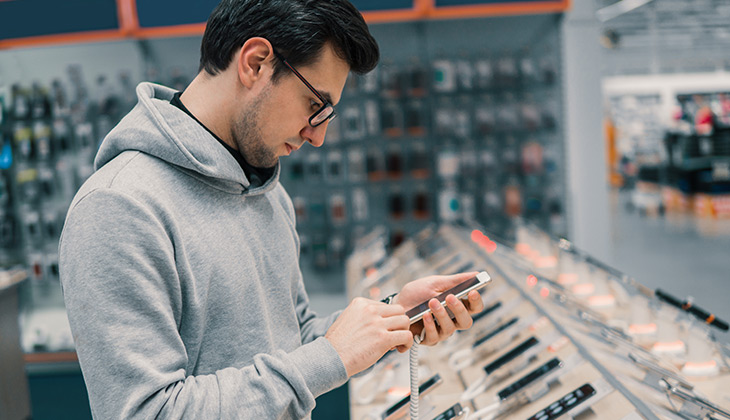
COMPANY
Mobile Telecom Operator
OPERATOR CHALLENGE
Losing customers in droves
Initial solution:
Strong-arm customers with contracts & scale up acquisition efforts
Initial results:
Made things worse, frustrated customers even more
Ultimate solution: Customer-first initiative
-
No more contracts
-
Anytime upgrades
-
Extended all new customer offers to existing customers
Ultimate results:
-
Customer satisfaction ratings jumped from worst to first in the industry
-
Reduce churn by 75%
-
Revenue nearly doubled over next 3 years
(McKinsey & Company)
McKinsey’s research shows that when brands focus on delighting their existing customers, it results in concrete financial outcomes. And this is precisely what loyalty is designed to do.
Personalization and loyalty programs are key to strengthening customer relationships. In a recent Customer Think article, Consultant Colin Shaw of Beyond Philosophy LLC shares that customers want authentic experiences from brands and, ultimately, it’s all about delivering experiences that customers value. When you do this, customers will want to spend more money with you. Loyalty data helps you tap into what your customers really value.
Delivering personalized experiences today across digital channels, in-store and more takes a village. And loyalty enables that village with the data, technology and insights to respond to evolving customer preferences and needs in real time.
“Companies that don’t achieve sustainable growth typically fail to invest in engagement and retention. CX leaders, by contrast, are masters at the art of cultivating growth from existing customers by making it enjoyable to use ever more of the company’s products and services.”
– McKinsey & Company
CX and loyalty are intertwined
Conversations about loyalty strategy inevitably open your eyes to gaps in your overall customer experience—and your loyalty program can be the key to filling them. Your loyalty program shouldn’t be a separate initiative or an afterthought. Done right, it should be an integral part of your business strategy. Loyalty impacts and can help improve every aspect of your business—especially customer experience—and bad experiences are the top reason for losing customer loyalty.
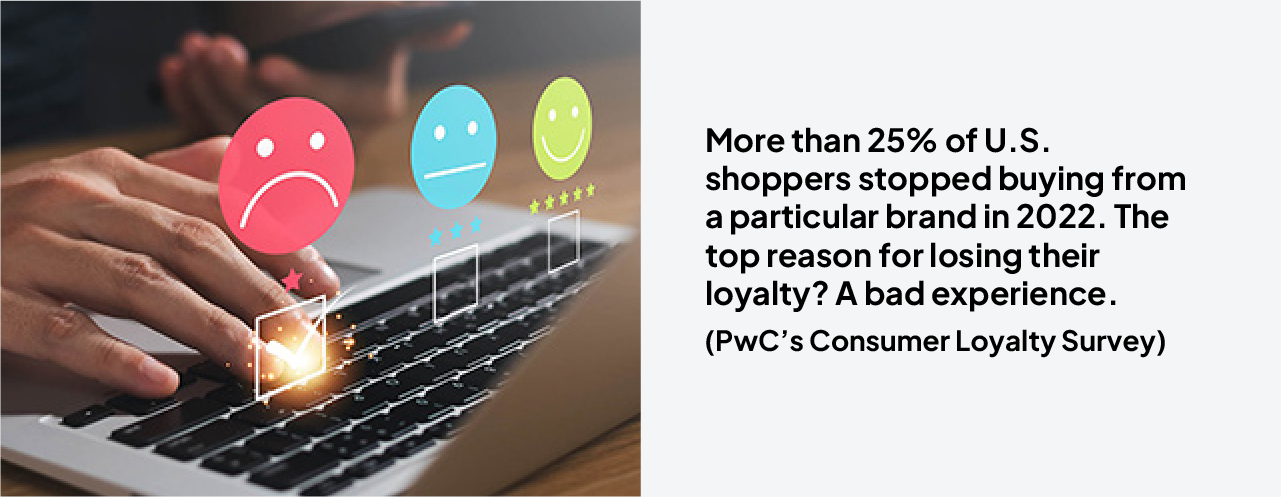
“We’re seeing more and more retailers move their loyalty programs from transactional programs to more of a data collection engine that’ll help them create more personalized customer experiences. A loyalty program is a way to gain consent from a customer to use their data. Additionally, when joining a program, a customer commits to identifying themselves at every touchpoint. Within a program, brands are using progressive profiling to create fun and interactive ways to collect data from customers that they can then turn into meaningful dialogue at the POS or clientele level.”
– Mark Woodward, CEO, Annex Cloud
How consumers define a better experience
If access, price and products were the same, consumers would choose one retailer over another based on:
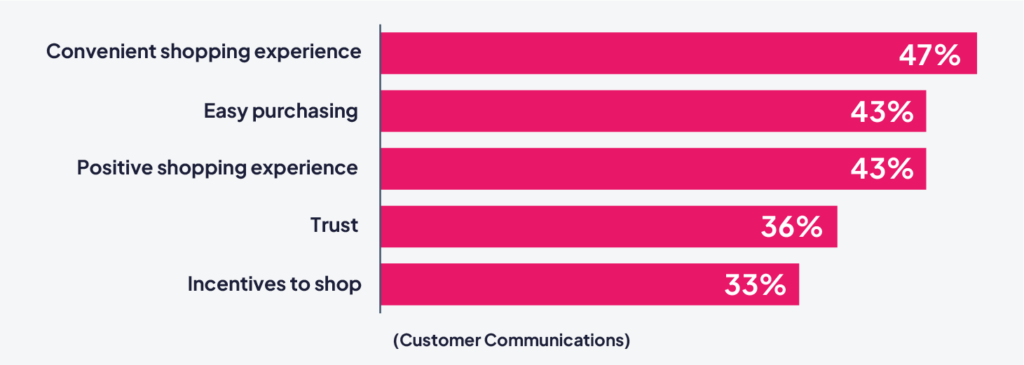
“Many organizations don’t understand loyalty and view their program as a tool to generate sales, as a 52-week promotion instead of a structural corporate initiative or the core strategy of the organization. This vision means that the program is seen as a cost center, and the focus is on the transactional. Our experience at R3 marketing has taught us that the most effective and profitable programs are those whose objective is to foster engagement by offering members added value (personalized content and offers, useful features, benefits that foster an emotional bond with the brand, etc.) and not just to offer points for purchases.”
– Hans Laroche, Consultant principal marketing, R3 Marketing
6 customer experience goals—and how loyalty helps you achieve them
According to McKinsey & Company, experience-led growth leaders invest in new offerings and experiences—and loyalty data can help inform these decisions—enabling brands to improve their customers’ experiences while monetizing customer data.
Here are six ways loyalty helps you achieve your customer experience goals.
1. Know your customers
Getting to know your customers and understanding their preferences and values is all about the data. And according to McKinsey & Company, growth outperformers are much more likely to know their customers personally.
Forbes reports that data is the lifeblood of an effective personalization program—and a loyalty program provides consistent, accurate and unique zero- and first-party data with consent at scale. Loyalty programs create endless opportunities to engage customers and collect more data, enabling your brand to continually improve personalization and customer experiences for returning customers.
“The most important thing retailers can do to drive loyalty with omnichannel strategies is going the extra mile to get to know their customers—when and where they shop, their buying habits, and developing a strategy that meets their customers where they are.”
– Airon White, Senior Manager, Product Marketing, BigCommerce
Some zero- and first-party data collection methods you can leverage through your loyalty program include:
-
Product recommendations
-
Program and newsletter signups
-
Members communities
-
Branded apps
-
Customer surveys
In order to know what your customers value, you need to ask them—and your loyalty program allows you do that as part of the ongoing loyalty conversation.
“Explicitly asking customers and prospects what they want to hear and see from your brand, instead of just inferring those answers from their behavior, is an excellent opportunity to build deeper relationships with customers and prospects. It allows them to control the conversation. Keep information simple and transparent and give people the choice to say yes or no. You’re far more likely to obtain information that will be accurate, and your communications will be more welcome. It may require a bit more of a lift going in, but you’ll be rewarded with zero-party data that your customers are freely sharing because they want to hear what your brand has to say.”
– Steve Henderson, Head of Deliverability, Emarsys
Big Hammer Wines uses a product recommendation quiz to personalize its offering and segment its audience. The brand also uses it as an opportunity to capture users’ email addresses in exchange for a $50 discount on orders over $150. Customers who order more frequently enjoy free shipping, while others prefer discounts on their most-ordered products. Brands can use quiz responses to optimize campaigns and better target audiences with relevant offers.
2. Personalize and act on customer data in real time
The best customer experiences are the result of an on-going dialogue between your brand and your customers. While it’s great to know what they buy and when, knowing why they buy makes a huge difference in your ability to make their experiences more personal, meaningful and valuable.
Amazon is the unquestioned king of personalization. The ecommerce giant uses all the data from your Amazon account to ensure you’re constantly served hyper-personalized product recommendations, building a huge following of fiercely loyal customers. Users are targeted with product suggestions ranging from broad and generalized to highly specific.
According to Deloitte, the ability to recognize and use emotional data at scale is one of the biggest, most important opportunities for brands going forward. Your loyalty program gives you endless opportunities to directly ask your customers what they value and prefer versus making assumptions or guessing. Then you can tailor their experiences based on the details they share.
“While it’s a great idea for retailers to keep an eye on the evolution of technology to leverage in the business, investing in a data strategy is ultimately the most important technology a retailer can use. There is so much power in data, and it is created at every single touchpoint on the customer’s journey. When retailers couple their gut instincts with data-driven decisions, selling online and in-store not only meets their customers expectations, it begins to exceed them.”
– Airon White, Senior Manager, Product Marketing, BigCommerce
Progressive profiling allows you to gradually add unlimited attributes to your member profiles over time. These attributes give you insights into members’ preferences, priorities, values, lifestyles and more—enabling you to deliver personalized content, offers and rewards that resonate with them. Grocery retailer Kroger provides personalized rewards, such as personalized coupons for fuel or grocery items they frequently purchase, to encourage consumers to shop with them versus competing discount retailers.

Loyalty platform functionality, such as Annex Cloud’s Loyalty Experience Platform™ advanced segmentation, makes it quick and easy to create segments based on any combination of attributes. The more granular the segments, the more relevant and meaningful offers and rewards you can deliver. And it’s highly configurable, so marketers can modify segments, tiers, offers, rewards and more on the fly. This allows them to quickly and easily test different offers and rewards to see what is or isn’t working, and easily modify under-performing campaigns. The ability to personalize loyalty offerings enhances your experiences, fosters loyalty and drives business value.
“Brands need to start owning the relationship with customers, collecting data and insights from customers to meet their expectations and deliver personalized experiences and messages. A strong loyalty strategy is a great enabler allowing to collect zero and first-party data in a transparent way, both helping to personalize the customer experience and to build trust customers have in brands. Trust, personalization, and recognition through rewards enhance the overall customer experience, making it more relevant and engaging.”
– Andréanne Rondeau, Loyalty Expert, stratLX
3. Increase engagement
Loyalty is designed around a mutual value exchange. Customers share their data in exchange for your brand using that data to tailor their experiences. Combining robust loyalty data with the opportunities your loyalty program provides to continually engage your customers enables your brand to deliver value-driven personalized engagement. Every interaction is an opportunity to know more about your customers as well as deliver unique, meaningful value based on what you know about them.
“To give customers the truly personalized experiences they want, you need their data, and you need their permission to have it. But there are hurdles to that. For one, you need to be aware of all the data privacy and security regulations for your region. But also, you also need to provide a compelling reason for a customer to want to share their data with your business. To put it simply: what’s in it for them? Not only do customers want assurance that you can handle their data with prudence and care, but they want value in exchange for their data. So every brand’s mission should be to clearly demonstrate a value exchange: if a customer willingly gives you consent to use their data, in return, you give them value in the form of a highly relevant, personalized shopping experience that they can’t get from any other brand.”
– Bastain Hagmaier, SVP Services (EMEA), Emarsys
Modern loyalty solutions offer a wide range of engagement options to keep customers engaged between transactions, including social loyalty, gamification, referral programs, ratings and reviews, and more. These can make your customers’ experiences more fun and rewarding, especially if you incentivize participation. And every interaction leads to more data that can be used to deliver an even more relevant and personalized experience.
“Our research at R3 Marketing has shown us that new generations understand the notion of exchange with brands: I share my data as a customer, but I expect to receive relevant, personalized content and offers. They are quick to leave programs that don’t meet this criterion.”
– Hans Laroche, Consultant principal marketing, R3 Marketing
4. Add unique value that goes beyond transactions
Consumers want more than a transactional relationship with their preferred brands, and your loyalty program is the perfect way to add value between and beyond purchases. That explains why many brands are looking to expand their traditional ‘buy stuff, get points’ loyalty programs to include non-transactional value and exclusivity.

Engaging your customers and adding value between transactions can create lasting emotional bonds. And emotions can have an even stronger impact on loyalty than rational and brand factors.
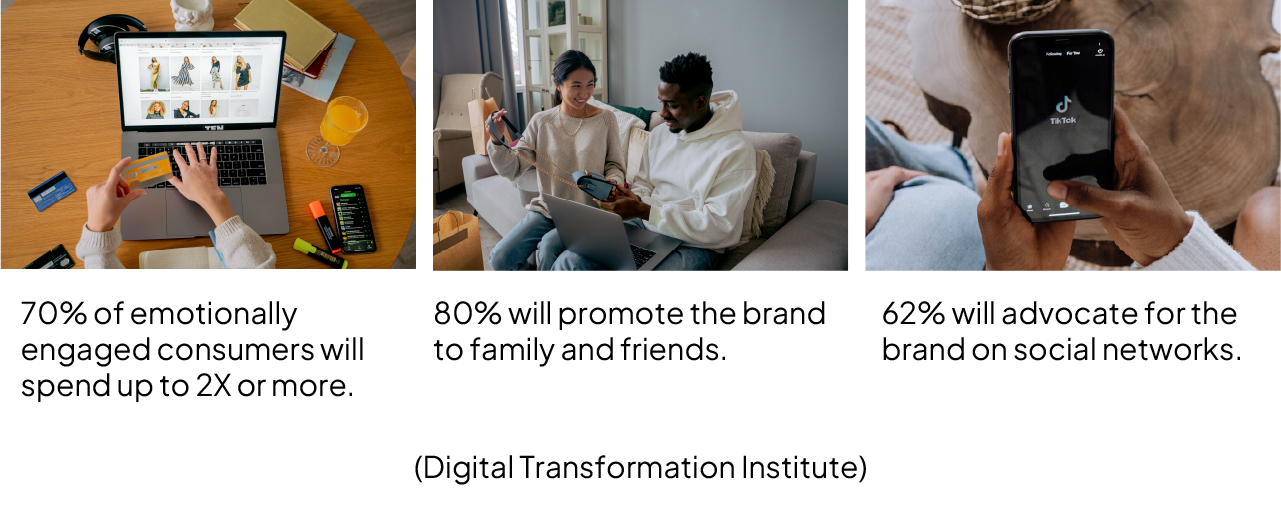
“With the lines between online and in-store experiences blurring, customers not only shop with their minds and wallets, but also shop with their hearts. They want to be able to relate to a brand and feel that same connection right back.”
– Airon White, Senior Manager, Product Marketing, BigCommerce
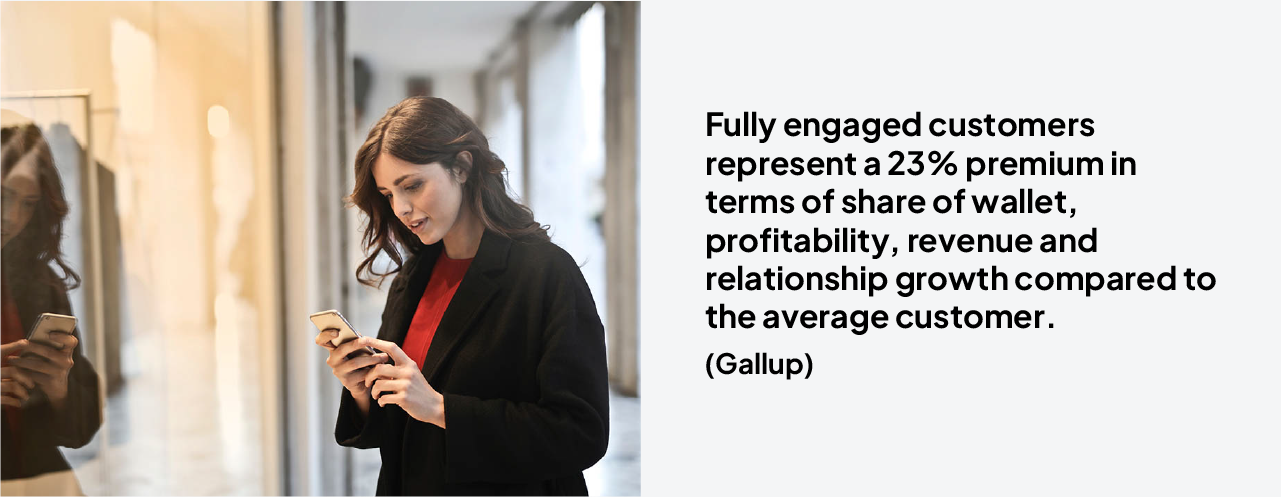
So, how do you add value beyond points or discounts? Leveraging today’s loyalty technology, the only limits are your imagination and creativity.
In his episode of our Get Personal with Loyalty podcast, The Point of Loyalty CEO Adam Posner talks about what he refers to as the ‘Collection of Six Currencies’ that loyalty program members care about:
-
Financial currency = show me the money
-
Experiential currency = add magical moments to my life (something Adam coined ‘joyalty’
-
Utility or functional currency = make my life easier
-
Personal currency = make me feel special (inclusivity)
-
Choice currency = letting me control my experience
-
Social or community currency = help me be a part of something and belong
According to Adam, “it goes transactional to emotional up because—everything from experiential, utility, personal, choice and social or community—all of those drive emotional senses and feelings.”

Ways to add non-transactional value with loyalty
Simply recognizing your customers can be a powerful reward—and there are plenty of other meaningful non-transactional ways to add value if you really understand your customers and what’s important to them. It can be helpful to measure your customers’ ‘share of life’, instead of just share of wallet. This expanded view opens up more and varied ways to become indispensable in as many aspects of people’s lives as possible, while continually creating and communicating savings that are invested back into the customer—reinforcing the loyalty loop.
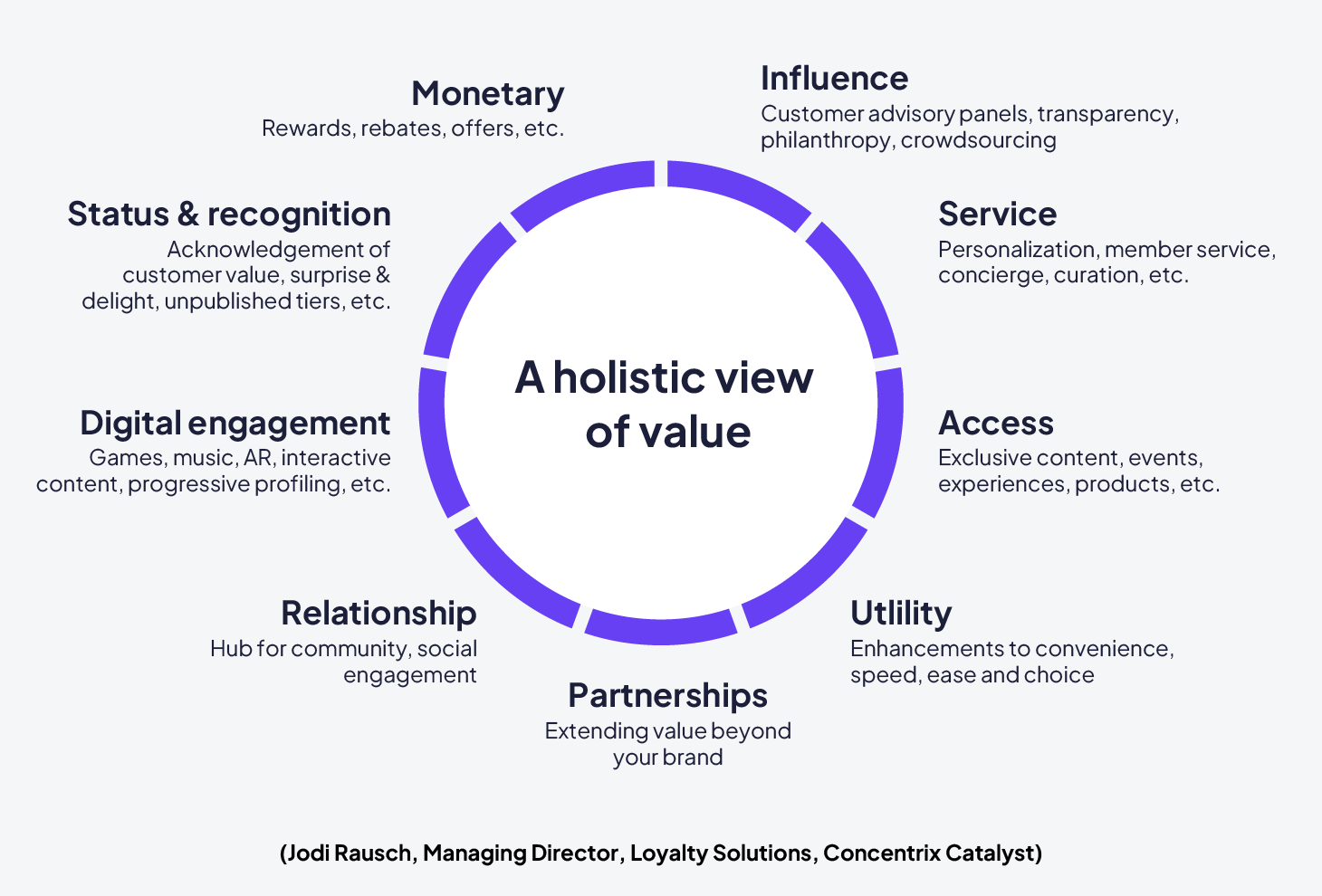
“Programs that balance monetary reward with experiential offerings—such as exclusive events, early access, or unique adventures—help brands appeal to both their consumers’ heads and hearts.”
– McKinsey & Company
Let’s take a closer look at some of these value options.
Digital engagement
Customer-centric brands are exploring gamification as a fun way to engage members while still collecting important data. Brands that incorporate gamification into their customer engagement strategies see a 47% rise in engagement, 22% rise in brand loyalty and 15% rise in brand awareness (themanifest.com).
Here are a few examples to give you some inspiration.
Just prior to the start of the National Basketball Association’s Golden State Warrior playoff game, Under Armour launched a Steph IQ mobile app (named after star guard Steph) that challenged players to answer basketball-themed questions to win a pair of Under Armour Curry 5 shoes, NBA Playoff tickets and a shared grand prize of $10,000 in Under Armour store credit. As soon as Curry landed his first three-pointer, fans were prompted to answer eight consecutively more difficult questions. Players only got one shot to score with each question, and a 10-second shot clock pressured them to answer quickly.

Domino’s used a game to engage mobile customers with its brand while educating them about the company’s ordering capabilities. The ‘Piece of the Pie Pursuit’ mobile game put players in the center of Domino’s latest TV commercial, which highlighted how people can order Domino’s via phone, online or in store. Each section of the game featured pizza-themed challenges, such as guiding a pizza cutter car along a virtual track in a race against the clock and using a sauce spoon as a catapult. Players who beat all six levels in the game received 10 Piece of the Pie Rewards bonus points toward their next qualifying order. Customers who reached 60 points could redeem them online for a free medium two-topping pizza.

Convenience
Armed with robust loyalty data that reveals your members’ value, preferences and lifestyle—you can serve up all sorts of ways to make your customers’ lives easier. Leveraging mobile offers even more options.
“Offer mobile functionalities that save members time and/or make their lives easier (e.g., Skip the Line at Starbucks, see your purchase history, read a bar code to learn more about a product, see my personalized offers, etc.).”
– Hans Laroche, Consultant Principal Marketing, R3 Marketing
Baby brand The Honest Company has an intuitive app customers use to order more products, access discounts and get first dibs on new additions. By collecting data from the app, Honest Company can better segment its audience and further personalize marketing campaigns.

Lowe’s launched its MVPs Pro Rewards and Partnership Program in February 2022, and has since expanded the offering to include a new suite of time-saving tools for professionals on the retailer’s website and mobile app. The MVPs Business Tools aim to simplify the resupply process with:
-
Online quotes—Instead of going in store or calling to get a quote, pros can now build and update order quotes online within minutes, with pricing guaranteed for seven days
-
A volume savings program—Silver Tier and above MVPs Pro Rewards members will be able to unlock savings on eligible orders of $1,500 or more
-
Buy it again functionality—Enables easy reordering of frequently purchased items, with the ability to sort previous orders by frequency, recency and price of purchase
-
A centralized page—To view purchases and track deliveries
“We know that for pros, time is money. As demands on their time increase, new technologies like the MVPs Business Tools help Pros be more efficient and stay focused on their business. These enhanced digital features replicate our fast and simple in-store shopping experience so pros can manage their orders from anywhere, whether that’s on the job site, at home or out of town.”
– Tony Hurst, SVP of Pro and Services, Lowe’s
IKEA’s Business Network loyalty program blends B2B and B2C loyalty program benefits. It’s free to businesses of all sizes. Perks for member companies and their employees include:
-
Access to IKEA Family (the company’s consumer loyalty program) benefits, including 5% savings on eligible in-store purchases, select discounted delivery, seasonal promotions and receipt tracking
-
The opportunity to utilize IKEA’s newly launched Interior Design Service
-
Member discounts for all company employees on automobiles, food and dining, insurance, travel, tickets, health and fitness, electronics and more through BenefitHub
-
An online training program that focuses on three categories—spaces, people and business
-
A free coffee or tea at every visit to the IKEA Swedish Restaurant
Exclusivity
All of us want to feel special, and your loyalty program is an ideal way to deliver exclusive members-only benefits. These can include exclusive rewards, early access to new products and much more. You can incent members to reach higher tiers to unlock VIP benefits, or you can reserve these sought-after benefits for paid-only members. Modern loyalty technology lets you easily mix-and-match loyalty program types to fit your needs.
After identifying the top 1% of their customers, a home décor/furnishing retailer recognized these customers were changing their home with the seasons, spending upwards of $20K per year. They sent these customers an email from the CEO personally thanking them for being one of their best customers, inviting them to receive a special gift. Store employees were trained to get the Store Manager to tell them in person how much they appreciate them and present them with a gift (candle or other home item), making an instant emotional connection.
Timberland launched its first U.S.-based membership program called Community. Consumers can sign up for free on timberland.com as well as unlock benefits, early access to product launches, collaborations, energy moments, sales, promotional periods, free standard shipping, birthday discounts and a whole host of amenities—including on-site product customization and personalization, like laser etching and heat pressing embroidery. The brand’s signups were up 40% over expectations in March 2023 alone, and account creations were up more than 250%.
Community
Brand communities are increasing in popularity and are shown to improve retention and encourage more interaction between customers and brands. You can leverage your loyalty program to incentivize member participation—such as rewarding them for sustainable behaviors or allowing them to redeem loyalty points for charitable contributions. These types of experiences allow customers to get to know your brand on a deeper level and vice versa. Community building can an effective way to differentiate your brand, boost engagement and strengthen brand loyalty. And it can reduce acquisition and marketing costs.
“Some brands have yet to even explore digital marketing or paid advertising because their community is so strong. They spend so much time [building] it that it drives the direct-to-consumer revenue.”
– Kimberly Smith, Founder, Marjani, and Board of Directors, National Retail Federation
Fashion retailer ThredUp has re-invigorated resale by leveraging digital to bring the thrift shop directly to the consumer. The brand has effectively intertwined Environmental, Sustainability and Governance (ESG) practices into the selling and buying experiences of a new generation of consumers. ThredUp uses innovation, collaborative partnerships and community engagement to find ways for customers to improve their engagement in sustainable behaviors. Customers can also take advantage of ThredUp’s educational tools and resources, like their Fashion Footprint Calculator, empowering them to join the journey toward a sustainable retail future.

Publix stores are designed with sustainability in mind—including lighting, refrigeration and energy efficient systems and technology. The brand offers opportunities for customers to engage in sustainable habits while they shop, with electric vehicle charging stations, recycling areas and pharmacy recycling.
Partnerships
Expanding your brand’s value proposition through partnerships enables you to increase customer engagement while adding unique value you couldn’t offer customers on your own. Partnering with relevant brands can help you extend the reach of both brands while allowing members to enjoy perks from either brand.
Diners Club International leverages partnerships to offer members personalized rewards beyond what’s available in its catalog through gifts that include, for example, orthodontia, a down payment on a car or products from a wine cellar.
Grocery retailer H-E-B has partnered with home management platform Thumbtack, which will also be providing an on-demand home services capability in select stores. The partnership allows shoppers to find local handymen, lawn care and cleaning services while receiving a 10% discount.
Subscriptions
Unique loyalty data enables your brand to curate subscription programs according to member preferences. Personalized subscriptions boost customer value while reducing churn.


Pet-loving customers can enroll in Petco’s free Vital Care Core plan and receive members-only pricing for store items, personalized care notifications for their pets and points back for every purchase to be redeemed later. The brand’s Vital Care Premier plan costs $19.99 per month and includes all the same perks as well as 20% off grooming services, $15 a month in Vital Care rewards and unlimited routine vet exams at the company’s Vetco Total Care locations.

Mathis Home offers a subscription loyalty program that gives members exclusive pricing, free delivery and loyalty points for just $139 per year. The program consists of three levels based on spend—Shopper, Designer and VIP. Higher levels get additional benefits, such as early access to sales, extra points earning days, extra points on birthdays and special offers on luxury brands.
“The business landscape is highly competitive and rapidly changing. It’s becoming more difficult to compete on products and even more on pricing. A competitor can potentially copy a brands’ products and even services, but the knowledge a brand has of their customers, the relationship it has built with them, and the trust customers have in that brand can’t be copied. In this sense, a well-designed loyalty strategy that offers a great balance between recognizing financial engagement, offering personalized offers and content, exclusive experiences and value-added products and services not only provides benefits to customers, but also foster an emotional connection between the brand and the customer, which becomes a real advantage for driving sales, increasing customer engagement and increasing customer value life.”
– Andréanne Rondeau, Loyalty Expert, stratLX
5. Deliver a seamless, consistent omnichannel experience
In order to deliver an optimum customer experience, Forbes recommends approaching personalization holistically—that means translating real-time insights into one-to-one, relevant engagement across any channel, segment, locale or market. Personalization isn’t limited to loyalty—it’s about the entire customer experience—from banner ads, website content and deals to recipes, emails and more.
Delivering this level of personalization can be challenging given many enterprises have complex tech stacks. To complicate things even more, they may have customers and programs in multiple regions with different languages and currencies, and they may have multiple brands.
The right loyalty technology can be the glue that allows brands to easily replicate programs and experiences while allowing for localization. And integrations enable loyalty data to be pushed across the entire ecosystem, enabling personalization at every touchpoint. Your brand also needs the ability to allow members to redeem loyalty rewards through any channel, including your ecommerce site, mobile app, email, in store and more. Today’s loyalty technology helps your brand connect the dots between all customer-facing efforts, allowing you to recognize and reward customers consistently and in meaningful ways no matter where your customers engage and shop.
“Customer loyalty starts with data. Why? Because data allows you to truly understand the needs and wants of your customer, and that understanding is the basis of a long-lasting relationship. Questions like: What products or services does your customer like? Where do they shop? What’s their preferred method of communication? What motivates them to take action? Or, just as important: what do they dislike? Data reveals the answers to these questions. The problem is, it’s often scattered across your various data sets and channel information. So if you really want to start building lasting customer loyalty, unify your data and channels. When you bring it all together into a single platform, it’s like putting together the pieces of a puzzle to form a complete picture. The result is a complete 360-degree view of your customer, which is essential for personalized, omnichannel engagement. Once your data and channels are unified, you can better leverage that data across all your channels and make sure each customer receives a 1:1 experience that feels seamless, even as they move across touchpoints.”
– Michael Jonas, VP Client Success, Emarsys
6. Drive growth
Ultimately, your business goal is to drive profitable growth, and the best way to get there is by delivering a unique, relevant, personalized experience. Forbes reports that loyalty programs are proven to increase customer lifetime value by up to 30% by increasing frequency and spend per visit and winning back lost customers. Loyalty data can inform and enable a better customer experience across the entire journey, as well as improve merchandising, operations and more. Given today’s skyrocketing costs and shrinking margins, this is huge.

“By delivering more meaningful experiences at every touchpoint, customers not only feel more engaged, they start to trust in your ability to make them feel valued. This combined with a relevant rewards program will inspire customers to stay engaged. It becomes a virtuous cycle.”
– Forbes
A brand loyalty program spotlight
Target differentiates its brand by focusing their efforts around three pillars—ease, joy and affordability. A few years ago, the brand’s grocery assortment and loyalty program lagged behind other national retailers—but thanks to new positioning at the intersection of affordability, one-stop shopping and experiential retail, both in store and online—they’re enjoying a unique competitive advantage.
“At Target, we think about building a shopping experience that’s differentiated on multiple dimensions. But it’s really about creating an emotional connection to that consumer.”
– Christina Hennington, Chief Growth Officer, Target
The brand attributes its newfound advantage to five key strategies:
1. Taking a holistic approach to value
Value goes beyond just price—consumers also want quality, ease and convenience. For example, their dinner solution meal bags that cost $15 and include all the ingredients to make family-favorite recipes have been a huge success.
2. Using assortment as a differentiator
A three-pronged approach provides inspiration that includes their own brands, national partners who can offer exclusive, limited-time items, and small, emerging brands—including commitments to minority-owned brands.
3. Offering newness, health and wellness
For example, a vegan, plant-based line that’s affordable has done extremely well.
4. Embracing omnichannel
Target customers intertwine shopping methods, so they’ve expanded same-day services and added in-store Starbucks cafes to its curbside pickup service. They don’t need to promote this service, social media is driving its success.
5. Creating a customer-focused loyalty program
Target’s initial loyalty program was transactional, and they learned the hard way it needed to fully glean shopper insights. The brand’s new program, Target Circle, puts personalization at the center—allowing members to unlock offerings that are tailored and relevant to them, and letting them vote on which local charities that want Target to donate to—connecting its loyalty program data with its retail media network to further boost its customer experience and deepen vendor relationships.
The right technology is essential to
improving your CX
Technology can make or break your ability to deliver the experiences your customers expect. Here are the must-have requirements you should look for when evaluating your loyalty platform options:

Flexibility
The ability to easily and quickly configure and reconfigure based on your changing requirements, as well as act on customer data in real time.
Scalability
The ability to easily support growth, including unlimited members and attributes, expansion into other markets, and adding brands.
Speed
The ability to act on new opportunities and adjust in real time based on what’s working or not working—quickly and easily—without re-coding, development or costly services.
Innovation
The ability to continually enhance features and functionality to maximize your competitive edge—quickly, easily and affordably.
Connectivity
The ability to seamlessly integrate with the rest of your tech stack to deliver omnichannel experiences.
“It’s important to define your growth, customer experience and loyalty strategies before evaluating and choosing your technology partners. One thing is for sure—your technology must be flexible to allow you to quickly adapt to ever-changing preferences and needs, as well as continually allow you to differentiate your brand.”
– Erin Raese, SVP of Growth & Revenue, Annex Cloud
Brands that are nailing personalized, value-driven experiences
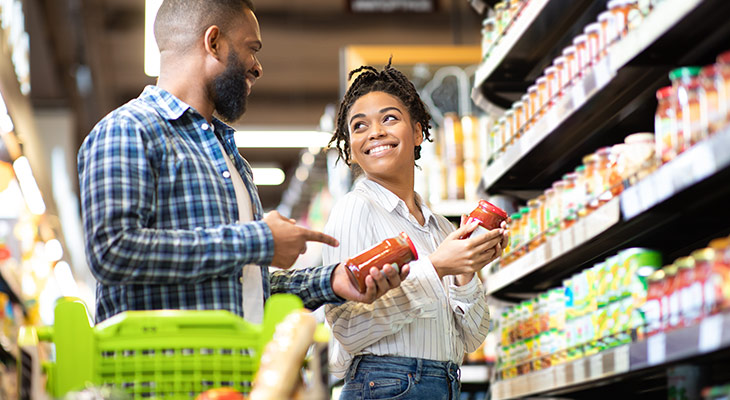

Sprouts Farmers Market is working to boost customer engagement through personalizing experiences in its efforts to entice its most-loyal customers to shop more often and put more items in their carts when they do. And their efforts are paying off. Same-store sales climbed 3.1% during its first quarter in 2023, with its most-loyal shoppers driving 60% of sales.
Sprouts’ customer-engagement efforts are multi-pronged and include a renewed focus on service, ramped-up sampling program, increased checkout speed, expanded omnichannel offerings, and data-driven media that targets shoppers with customized marketing.
“The way we’re thinking about ecomm is very much on an omnichannel basis, that the customer will choose how they want to transact with Sprouts. The thing that’s encouraged us about the ecommerce growth is that, in a grocery environment, it is relatively easy for people to buy from whomever they feel like. And the fact that they can only get the assortment from Sprouts, that we sell, gives me some confidence that customers are navigating their way to our curated assortment in a very positive way.”
– Jack Sinclair, CEO, Sprouts

Sephora’s loyalty program clearly demonstrates the effectiveness of focusing on the most loyal customers. The company’s three-tiered loyalty program, Beauty Insider, offers its highest-level members early access to new products, invitations to exclusive events, free custom beauty services and more. All members receive baseline benefits, including customized recommendations based on profiles they fill out online. Their profile details—such as first name, buying habits and quiz responses—are deployed across channels. Store associates can access a customer’s profile in store and track items that were sampled, making it easy for customers to find and buy those items on the website or app. Higher tiered members enjoy more choice, higher discounts and more exclusive samples. Every communication from the brand, on every platform, displays the customer’s loyalty points, and offers are synchronized across platforms.
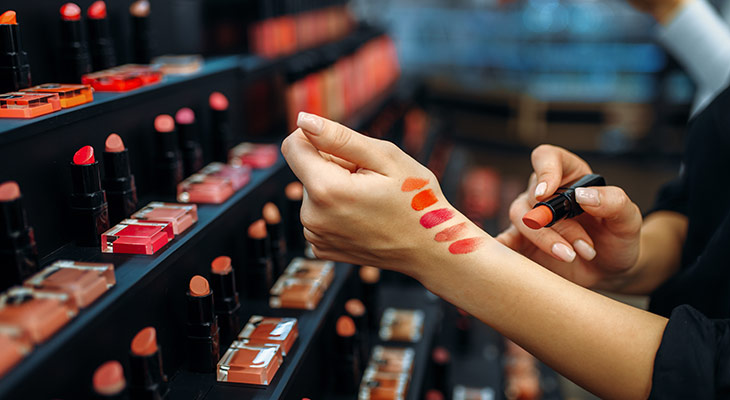
Sephora’s personalization efforts are driving growth. The loyalty program now has around 31 million U.S. members. The majority of sales comes from Beauty Insider members. Part of what keeps the program successful is frequently revamping its loyalty perks, with a focus on the elements its shoppers want most. Sephora knows value and convenience are particularly important to members. The brand expanded free shipping to all Beauty Insider members, as well as offerings BOPIS and same-day delivery. Members can’t wait for Sephora’s spring and holiday sales. Even their birthday gift is more than a discount, it’s a choice between a range of specially chosen gift options. And the brand’s partnership with Kohls is expanding their reach to a different, older demographic. New members have joined through Kohl’s stores and website, and former Sephora members have reactivated their accounts because of the Kohl’s partnership.
“It’s core to how we are keeping a vibrant program going. We keep on trying to make sure that we’re offering the best loyalty elements possible. We really think of value broadly and it’s more than just discount. Obviously discount is a key part of it, but we also offer value through the samples that we offer, through access to experiences like our virtual brand events … we’re trying to make sure that there’s a lot of different dimensions to the value that we offer as part of the program.”
– Emeline Berlind, Senior Vice President and General Manager of Loyalty, Sephora

This membership-based retailer of organic, healthy products immediately invites new signups to take an interactive shopping quiz to help them find products perfectly suited for their individual needs. The data collected immediately starts to tailor the shopping experience. The more you shop with them, the more advanced the personalization becomes. They make it easy to shop by specific dietary restrictions. Every engagement fuels deeper insights and more impactful personalization. When a favorite item is out of stock, they set a trigger to inform the member when the item is available again.
“Sometimes what you don’t send is just as important as what you do send. Imagine if a vegan shopper received a promotion for bone broth or beef jerky? Perfect for a paleo member, but a deal-breaker for someone that doesn’t eat meat.”
– Sasha Siddhartha, Co-founder and CTO, Thrive Market
5 steps to start moving toward a better customer experience
Improving your customers’ experiences through personalization and loyalty may seem overwhelming. It’s an evolution, a journey, and the key is to just get started.
These five steps will put you on a path to happier, more loyal customers, higher margins, a more differentiated brand and revenue growth.
1. Prioritize your customer journey enterprise-wide
Forbes recommends making customer experience, customer success and customer loyalty a company priority as an effective way of future-proofing your business. If you currently have loyalty and/or customer experience as standalone teams with siloed systems, it’s time to expand your vision and strategies. Customer experience is everyone’s responsibility and in order to deliver a seamless, personalized, omnichannel experience—you all must be singing from the same universal song sheet.
2. Focus on your best customers
McKinsey & Company advises brands that, to maximize the results of a personalization program, you should focus initially on your most loyal customers, as programs targeting regular shoppers yield a return on investment three times higher than mass promotions. Moreover, building data on your most loyal customers sets off a virtuous cycle by generating ever-more-relevant data and higher response rates that further boost data quality.
3. Treat data as a strategic asset
Customer data is the lifeblood of your organization, so collecting it, managing it and leveraging it should be a strategic part of your growth plan. Loyalty platforms, such as Annex Cloud’s Loyalty Experience Platform, enable you to collect zero- and first-party data with consent at scale while adhering to all the global data privacy regulations.
4. Make sure you have the right loyalty platform
If you’re still relying on a legacy loyalty solution, it’s time to understand the limitations and explore some of the modern loyalty solutions options. And many enterprises automatically assume that a custom loyalty solution is their only choice because their needs are too complex. Today’s SaaS loyalty platforms offer flexibility, scalability and control that’s worth looking into. And integrations allow you to seamlessly push customer data across your tech stack to enable personalization of every touchpoint.
5. Take a phased approach
Start by identifying key touchpoints in your customer journey and work on feeding and leveraging data for these interactions. McKinsey & Company recommends defining a short list of high-impact use cases that are relevant to your consumers but not too complex to execute against. Then construct an integrated database for these use cases. Test and learn from experiments. Test offers and rewards on micro segments before rolling out to the masses. The key is to test and learn while building the necessary capabilities and intelligence.
Annex Cloud can help you close your CX gap
Annex Cloud can help you bring your customer experience vision to life. Our SaaS-based loyalty platform, aptly named the Loyalty Experience Platform, is designed for even the most complex global brands. Our technology-first approach and continuous innovation gives you a distinct competitive advantage and provides everything you need to engage, personalize and retain your best customers.
Comprehensive
You need far more than a points engine. Get a complete set of next-gen capabilities, plus instant access to new features and functionality.
Agile
Deploy and reconfigure quickly. Our fully configurable, self-service platform makes it easy for your marketing team to add, change, segment, test, pivot and update—no recoding or development required.
Scalable
Easily and securely accommodate growth, expand into other regions and brands, anywhere across the globe. Collect unlimited member attributes and act on any combination to engage, recognize, reward and convert members—leading to higher customer lifetime values.
Omnichannel
Deliver seamless, consistent experiences by leveraging our 125+ integrations with all the top technologies. We’re constantly innovating to ensure future-forward platform interoperability that works with your martech stack as it evolves.
Economical
Your needs and your customers’ needs will change. That’s why our loyalty solution empowers your teams to quickly and easily reconfigure, add, change and update segments, tiers, rewards and more on the fly—without time-consuming and costly development or expensive services. Automatically get new functionality. And maintenance and support are done for you—so your IT resources can focus on more strategic, growth-oriented initiatives.
Your loyalty program gives you the opportunity to reimagine and redesign your customer journeys, creating value-driven customer experiences around the personal relationships between your customers and your brand.
Let’s explore where we can take your customers’ experiences—together.



